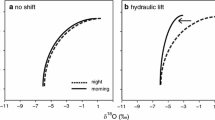Abstract
Frequency, duration, depth, and timing of flooding are major influences on the structure and functional dynamics of wetland ecosystems. In the present study, ground-water and surface-water dynamics were continuously measured on four long-term study sites in the Great Dismal Swamp. The hydrologic patterns were examined in relation to previously measured processes. Conclusions drawn from these comparisons include (1) increased winter and spring flooding results in greater aboveground production but less belowground production, (2) higher leaf litter decay rates correspond with longer duration of flooding in wet years and with longer duration of saturation of the upper soil layers in dry years, and (3) the relationship between flooding and decay of leaf litter and roots is complicated by the strong influence of the chemical and structural nature of the litter. Erroneous interpretations of hydrologic relationships may result from observations of surface flooding dynamics alone. In the Great Dismal Swamp, a significant reversal occurs in the order of sites ranked on the basis of the amount of flooding aboveground versus the duration of saturation below the soil surface.
Similar content being viewed by others
Literature Cited
Atchue, J.A., F.P. Day, and H.G. Marshall. 1983. Algal dynamics and nitrogen and phosphorus cycling in a cypress stand in the seasonally flooded Dismal Swamp. Hydrobiologia 106: 115–122.
Brinson, M.M., A.E. Lugo, and S. Brown. 1981. Primary productivity, decompo sition and consumer activity in freshwater wetlands. Annual Review of Ecology and Systematics 12: 123–161.
Brinson, M.M., H.D. Bradshaw, and E.S. Kane. 1984. Nutrient assimilative capacity of an alluvial floodplain swamp. Journal of Applied Ecology 21: 1041–1057.
Brown, S. 1981. A comparison of the structure, primary productivity, and transpiration of cypress ecosystems in Florida. Ecological Monographs 51: 403–427.
Carter, V. 1986. An overview of the hydrologic concerns related to wetlands in the United States. Canadian Journal of Botany. 74: 364–374.
Conner, W.H., J.G. Gosselink, and R.T. Parrondo. 1981. Comparison of the vegetation of three Louisiana swamp sites with different flooding regimes. American Journal of Botany 68: 320–331.
Dabel, C.V., and F.P. Day. 1977. Structural comparisons of four plant communities in the Great Dismal Swamp, Virginia. Bulletin of the Torrey Botanical Club 104: 352–360.
Damman, A.W.H. 1986. Hydrology, development, and biogeochemistry of ombrogenous peat bogs with special reference to nutrient relocation in a western Newfoundland bog. Canadian Journal of Botany 64: 384–394.
Day, F.P. 1982. Litter decomposition rates in the seasonally flooded Great Dismal Swamp. Ecology 63: 670–678.
Day, F.P. 1983. Effects of flooding on leaf litter decomposition in microcosms. Oecologia (Berlin) 56: 180–184.
Day, F.P. 1985. Tree growth rates in the periodically flooded Great Dismal Swamp. Castanea 50: 89–95.
Day, F.P. 1987. Production and decay in aChamaecyparis thyoides swamp in southeastern Virginia. p. 123–132. In A. Laderman (ed.) Atlantic White Cedar Wetlands. Westview Press, Boulder, Colorado, USA.
Gomez, M.M., and F.P. Day. 1982. Litter nutrient content and production in the Great Dismal Swamp. American Journal of Botany 69: 1314–1321.
Harriss, R.C., D.I. Sebacher, and F.P. Day. 1982. Methane flux in the Great Dismal Swamp. Nature 297: 673–674.
Lichtler, W.F. and P.N. Walker. 1979. Hydrology of the Dismal Swamp, Virginia — North Carolina. p. 140–168. In P.W. Kirk (ed.) The Great Dismal Swamp. University Press of Virginia, Charlottesville, VA, USA.
Mitsch, W.J. and K.C. Ewel. 1979. Comparative biomass and growth of cypress in Florida wetlands. American Midland Naturalist 101: 417–426.
Mantague, K.A. and F.P. Day. 1980. Belowground biomass of four plant communities of the Great Dismal Swamp, Virginia. American Midland Naturalist 103: 83–87.
National Oceanographic and Atmospheric Administration. 1984, 1985, 1986. Climatological data for Virginia, Annual Summary. U.S. Government Printing Office, Washington, D.C., USA.
Paratley, R.D. and T.J. Fahey. 1986. Vegetation-environment relations in a conifer swamp in central New York. Bulletin of the Torrey Botanical Club 113: 357–371.
Peebles, P.C., G.H. Johnson, and C.R. Berquist. 1984. The middle and late Pleistocene stratigraphy of the outer coastal plain, southeastern Virginia. Virginia Minerals 30: 13–22.
Symbula, M. 1987. Evaluation of two methods for estimating belowground production in the Great Dismal Swamp, Virginia. Master’s Thesis. Old Dominion University, Norfolk, VA, USA.
Wharton, C.H., W.M. Kitchens, E.C. Pendleton, and T.W. Sipe. 1982. The ecology of bottomland hardwood swamps of the southeast: a community profile. U.S. Fish and Wildlife Service, Biological Services Program, Washington, D.C. FWS/OBS-81/37.
Yates, R.F.K. and F.P. Day. 1983. Decay rates and nutrient dynamics in confined and unconfined leaf litter in the Great Dismal Swamp. American Midland Naturalist 110: 37–45.
Author information
Authors and Affiliations
Rights and permissions
About this article
Cite this article
Day, F.P., West, S.K. & Tupacz, E.G. The influence of ground-water dynamics in a periodically flooded ecosystem, the Great Dismal Swamp. Wetlands 8, 1–13 (1988). https://doi.org/10.1007/BF03160805
Issue Date:
DOI: https://doi.org/10.1007/BF03160805




